
Image by NathanaelB via flickr
They were pretty common with bands at least in the 1970s and 1980s, and probably still are – electronic synthesizers. Just check out video and sound of this Depeche Mode song ‘Just can’t get enough.’ Synthesizers generate artificial sounds by breaking these down into their individual frequency components and then generating these components artificially. In a paper published in Science this week, Andy Kung and colleagues from the Institute of Atomic and Molecular Sciences of the Academia Sinica in Taiwan and other Taiwanese institutions have now demonstrated the equivalent of electronic synthesizers, but for light.
Mathematically, to break down a sound or any other wave into its various frequencies is known as a Fourier transformation. To synthesize any given sound then also means to recreate it from those frequencies. This often requires a large number of frequencies, which isn’t always possible. The smaller the number of frequencies used in the synthesizer, the less accurate the sound. For example, to create a triangular wave from only two components is less precise than to use eight.
And this is the problem that has plagued optical synthesizers. For electronic synthesizers it is relatively easy to create a broad range of frequencies across the audible range of us humans. In the case of optical synthesizers, it is far more difficult. In fact, the 2005 Nobel Prize in Physics went to researchers that developed a technique that achieved very precise, evenly distributed laser frequencies over many octaves, and whose shape can be controlled as well.
In the present case, the researchers use a known, slightly different approach that seems easier to implement. They take two lasers of slightly different frequency. The frequency difference is tuned to be equal to the energy difference of two electronic states in hydrogen. Through nonlinear optical effects based on the interaction between the laser beams and the hydrogen molecules, a large number of beams with frequencies that are separated exactly by the energy difference of the hydrogen states is created. This ‘frequency comb’ spans several octaves.
In the Science paper, the researchers take five of these beams and put them through an experimental setup where their relative phase and intensity can be controlled individually. In this way they create an optical synthesizer that is able to approximate any given signal with five coefficients. Of course this isn’t much and if this would be an electronic synthesizer its output would sound pretty poor. As the authors mention, others have been able to generate 200 frequencies based on molecular interactions, although these authors did not make a synthesizer.
So even though the demonstration with five frequencies remains a somewhat embryonic implementation of an optical synthesizer, it should be possible to quickly expand this number to make better devices. What is most compelling about this technique appears to be the relative simplicity of the experiments that furthermore delivers optical waves at ultrafast speeds in the femtosecond range (one femtosecond is only a millionth of a billionth of a second) . This makes these waves of controlled shape interesting for telecommunication applications.
Reference:
Chan, H., Hsieh, Z., Liang, W., Kung, A., Lee, C., Lai, C., Pan, R., & Peng, L. (2011). Synthesis and Measurement of Ultrafast Waveforms from Five Discrete Optical Harmonics Science DOI: 10.1126/science.1198397


March 4, 2011
Photonics